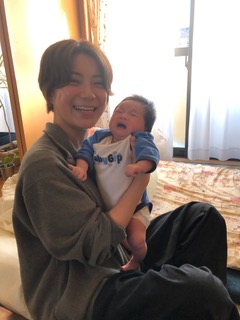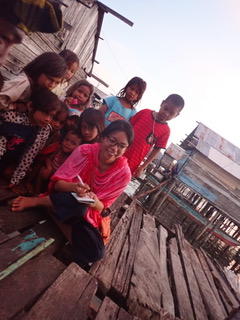
In 2020, there was no escaping the worldwide impact of the COVID-19 pandemic, and researchers and students on academic campuses were no exception. Many international and domestic conferences have been cancelled. Face-to-face communication in closed classrooms has been impossible. Prior to the pandemic, some disadvantages of online education, such as the lack of face-to-face interaction, had already been pointed out. 1 However, most universities decided to open lectures using online meeting systems only. 2
This article reports on an action by doctoral students during this situation – the establishment of an online association for graduate students – and suggests advantages and disadvantages, from the students’ point of view.
Conference cancellations meant not only that students lost the opportunity to make presentations but also that they lost the chance to discuss with other researchers and get feedback for their research from different perspectives. For young researchers, in particular, this could have a severe impact on their careers.
Professors and students were significantly impacted by the university blockade and switch to an online lecture format. Usually, spontaneous communication with other students and professors occurs everywhere on campus which helps students’ research activities. In other words, they lost many opportunities to experience campus life as well.
The situation for freshmen was worse. They have had limited opportunities to participate in academic communities, except for weekly seminars and classes. They do not know how to conduct their daily research, or to whom they should ask these questions. For some graduate students, this situation was more difficult because they were impacted from both perspectives, as young researchers and as students. Because of the conference cancellations, they lost the opportunity to show their work outside their universities. Dissertation defences in each university were conducted online. Therefore, they could not receive feedback directly. Moreover, they lost the chance to seek advice for their research from more senior researchers and professors through spontaneous communication on campus.
Establishing the Association of Young Researchers in Southeast Asian Area Studies

Authors were also hit by the impact of the pandemic. All of their scheduled presentations were cancelled. When this happened, most researchers and universities had no time to create a new online community because they were too busy preparing and thinking about how they would teach going forward. Doctoral students and young researchers were at a loss and simply disappointed because of the cancellation of conferences and the unpredictable situation. However, some small actions had already started. Some young scholars majoring in astronomy created a one-time-only conference named ‘Our Astronomy Conference’ (Watashitachi no tenmongakkai), in response to the situation. Makibi, one of the authors, joined this conference as an audience member and was inspired to start an online conference project with students in Southeast Asian area studies.
In April 2020, the Association of Young Researchers in Southeast Asian Area Studies was established, with the primary purpose of offering a presentation space for young researchers, especially graduate students.
Although the association and conference were established for graduate students to gain presentation experience, comments from the audience were also required as these are a significant benefit for presenters. Among the most critical aspects of organising a conference online were how to protect members from uninvited guests and how to enable interactive communication between presenters and audience members. 3

After the first conference, the organisers received requests from the audience and noted the need for interactive communication between the presenters and audience members. Today, our conference’s order is as follows: opening comments, first presentation, questions by ‘chat’, second presentation, questions by ‘chat’, break time, and question responses and discussion. Finally, after closing the meeting, there is an online gathering (voluntary participation), during which the presenters, organisers, and participants can freely talk face-to-face.
This online conference has been organised by AYSA more than five times, and various students and scholars have presented their research. In each meeting, there are more than 30 participants, and, on occasion, over 40 people have joined. Students from Kyoto University, Sophia University, Kanazawa University, and KU Leuven, Belgium, have carried out research presentations. The largest percentage have come from Kyoto University. However, the presenters and organisers are more diverse than before, consisting of different graduate schools, divisions, seminars, and disciplines. Research locations have included Indonesia, Laos, Vietnam, the Philippines, and even Madagascar and Ethiopia (for comparison with Southeast Asia).
Today, this group is organised by doctoral students at Kyoto University, Sophia University, Kanazawa University, and Hokkaido University. The organisers generally communicate using Slack, a workplace messaging platform. In this app, participants can freely chat and share files. It is organised for each conference by dividing up the channels within the forum.
Can an Online Association Fix the Existing Gaps in Student Research?
Staying in touch and creating new relationships with other students prior to and during the pandemic has been a serious problem. In fact, there are two main problems: the lack of a spontaneous association space and the existing gaps among academic communities.
The first problem is the disappearance of space for communication. When lectures and conferences were transported online, there was not much room for spontaneous or exciting communication. However, Slack offers space to communicate freely and spaces for each student to expand activities such as a book club or the creation of a panel for the symposium.
The pandemic situation pushed people towards online-based activities 4 5, and some associations are already using Slack. 6 However, many online academic groups have been based on existing communities of professors and students. In such cases, it is difficult for students to have random chats with others, which is related to the second problem.
The second problem are the existing gaps in the communication network. Nearly all online academic groups were based on existing closed communities. This means that people who typically have difficulty making connections cannot be involved in these groups, even if meetings are held online. Transitioning activities to an online format is not enough to overcome the existing gaps.
 For example, doctoral students majoring in Southeast Asia are scattered throughout various cities. Sometimes, it is too difficult to join a seminar or conference because of the problem of access. How can they conduct a presentation without sufficient money to finance a trip to a remote location? They have an economic disadvantage in comparison to professors. A student who is researching Indonesia says that no one else is researching Indonesia in his major. Therefore, They have no way of communicating with other doctoral students or young researchers studying Indonesia. The potential for this problem has existed, but, due to the pandemic situation, it has become more starkly apparent. In this regard, we can say that the pandemic has opened our eyes to the existence of such problems.
For example, doctoral students majoring in Southeast Asia are scattered throughout various cities. Sometimes, it is too difficult to join a seminar or conference because of the problem of access. How can they conduct a presentation without sufficient money to finance a trip to a remote location? They have an economic disadvantage in comparison to professors. A student who is researching Indonesia says that no one else is researching Indonesia in his major. Therefore, They have no way of communicating with other doctoral students or young researchers studying Indonesia. The potential for this problem has existed, but, due to the pandemic situation, it has become more starkly apparent. In this regard, we can say that the pandemic has opened our eyes to the existence of such problems.
To solve these issues, information about AYSA’s activities is open to all on the Internet, and people can join the conferences by registering. Slack space is made available by AYSA to all students who join as presenters and anyone who wishes to join. AYSA can be an online hub for young researchers and doctoral students in various situations. This Slack space could compensate for the lack of unofficial spontaneous communication on campus and expand the community beyond the limits of location, university, and discipline. AYSA can also represent the perspective of young researchers and graduate students because only graduate students organised this union. This means that AYSA could also be a hub that closes the generation gap.
We can also point out one more vital aspect of the breakthrough in the generation gap by online platforms. Because there are no seating orders on screen that are important in Japanese culture on screen, it makes communication fairer, somehow. This change could be one of the unique advantages of online associations, which might be different, depending on whether the organisation formed online, or the organisation is run using an online format. Fairness could be the main topic of the new era of communication. If people wish to expand the variety of unions online, they must understand online possibilities and change both their communication style and platform.
Future Outlook of Researchers’ Connections
While there are many positive impacts, online tools also have problems. For example, in an online space such as Slack, participants can ask questions and chat freely. The Graduate School of Asian and African Area Studies at Kyoto University, launched Slack in April 2020 with voluntary participation. Participants freely upload information about events, job hunting, recommended books, or creating a book club, in addition to having general chats. However, space availability depends on the enterprises of students. Sometimes, a certain online room is rarely activated, while other online platforms never close, causing students to become exhausted and leave them.
Other problems for AYSA and online conferences can be pointed out. First, online conferences and in-person gatherings each have their own advantages and disadvantages. 7 After several AYSA conferences, one of the participants, a professor, mentioned the timetable. He requested more time for sufficient discussion. However, he also said that if that was the case, the conference time would be long, and many professors would not be able to join. According to him, professors are currently very busy preparing their classes online and working in this unpredictable situation. Therefore, if it took only about an hour, they would likely join.
In other words, if sufficient time is devoted to discussion during the conference, someone will be satisfied, while others will not be able to participate. In addition, some participants mentioned the difficulty of speaking with the appropriate timing. While monitoring a display, people cannot know who wants to ask questions or speak, join an on-going conversation among others, or chat in a way that is unrelated to the theme. Moreover, online tools sometimes cause stress, which is a serious problem.
How about the needs and requests of non-participants in AYSA? They felt unsure because AYSA was an unknown new association for them. This is a characteristic problem of online associations. Some users mistakenly think the association is based on an existing closed community and hesitate to join because they do not have any acquaintances within the union. If people wish to create an open online association, explanations and an understanding of the association’s concepts are necessary.
Based on our impressions of the experience of establishing and conducting several conferences online, it was revealed that an online association with online tools is not a panacea. However, it is surely useful in terms of enabling students to communicate with other students spontaneously, and this link can expand even beyond the union. People already know the advantages and disadvantages of education, conferences, and associations held online. What is needed for future activities that use them is the perspective that bridging the gaps does fix certain problems one at a time in each case and provides advantages for online communication.
Makibi Nakano & Kumiko Kato
Makibi Nakano is a Ph.D. Student, Graduate School of Asian and African Area Studies (ASAFAS) in Kyoto University, Japan. She majors in Southeast Asian Area Studies focusing on the Sama-Bajau people in Indonesia, Ecological Anthropology, Maritime Ethnography, and Japanese Folklore. She is Manager of ‘Association of Young Researchers of the Southeast Asian Area Studies’ in Japan.
Kumiko Kato is a Ph.D. Student at the Graduate School of Global Studies, Sophia University in Japan.
Notes:
- O’Donoghue, J., Singh, G., & Green, C. (2004) A comparison of the advantages and disadvantages of IT based education and the implication upon students. Digital Education Review 9, 63–76. 2004 ↩
- COVID-19 and University Life in Japan. IZANAU <https://izanau.com/article/view/coronavirus-universities-in-japan> 30th September. 2020 ↩
- Nakano, M,. & Kumiko, K. 「東南アジア地域研究若手研究者の会の設立とオンライン開催の所感」.『 東南アジア学会会報』 (112) ↩
- Niner, H. J., Johri, S., Meyer, J., & Wassermann, S. N. (2020) The pandemic push: Can COVID-19 reinvent conferences to models rooted in sustainability, equitability and inclusion? Socio-Ecological Practice Research, 2.53–256. ↩
- Niner, H. J., Johri, S., Meyer, J., & Wassermann, S. N. (2020) The pandemic push: Can COVID-19 reinvent conferences to models rooted in sustainability, equitability and inclusion? Socio-Ecological Practice Research, 2.53–256. ↩
- Sharma, A. How I’ve connected other scientists online during COVID-19 pandemic. <https://www.sciencemag.org/careers/2020/04/how-i-ve-connected-other-scientists-online-during-covid-19-pandemic> 30th September. 2020 ↩
- Clark, T. Disadvantages of Collaborative Online Discussion and the Advantages of Sociability, Fun and Cliques for Online Learning. CRPIT ‘03: Proceedings of the 3.1 and 3.3 working groups conference on International federation for information processing: ICT and the teacher of the future. Volume 23. 23–25. 2003 The Association of Young Researchers in Southeast Asian Area Studies (AYSA) <https://wakateareastudies.blogspot.com> 30th September. 2020 ↩


